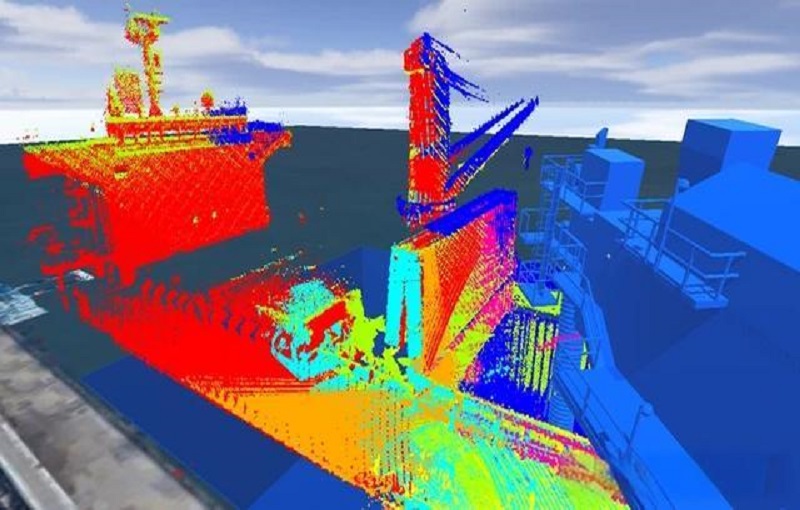Introduction
LiDAR technology on smart ships is highly sensitive to environmental conditions, which can significantly impact its performance. Marine environments present unique challenges, including weather conditions, sea states, and exposure to saltwater and marine growth. This article will explore these environmental considerations and offer strategies for mitigating their effects on LiDAR systems, ensuring reliable performance in various maritime settings.

Impact of Weather Conditions
Weather conditions are one of the most significant environmental factors affecting LiDAR performance. Fog, rain, snow, and even humidity can cause the laser beams emitted by LiDAR systems to scatter or reflect, leading to inaccurate measurements. For example, dense fog can cause the laser beams to disperse, reducing the effective range of the LiDAR system and potentially causing false readings.
To mitigate the impact of weather conditions, smart ships can be equipped with additional sensors that monitor environmental factors in real-time. By integrating this data with the LiDAR system, the ship’s crew can adjust the system’s settings or switch to alternative navigational aids when necessary. In some cases, it may be possible to use algorithms that compensate for specific weather conditions, improving the accuracy of the LiDAR data.
Sea States and Their Effects on LiDAR
Sea states, or the condition of the sea’s surface, can also impact LiDAR performance. Rough seas, characterized by high waves and swells, can cause the ship to pitch and roll, leading to unstable LiDAR readings. Additionally, waves can reflect LiDAR signals in unexpected ways, potentially causing false positives or missed detections.
To address these challenges, LiDAR systems on smart ships should be equipped with stabilization mechanisms that compensate for the ship’s movement. This can include gimbals or other mechanical systems that keep the LiDAR sensors level even in rough seas. Additionally, software algorithms can be used to filter out false readings caused by waves, ensuring that only relevant data is processed.
Saltwater Exposure and Corrosion
Saltwater exposure is a significant concern for any equipment installed on a ship, including LiDAR systems. The corrosive nature of saltwater can damage the LiDAR sensors, mounting hardware, and electrical connections, leading to system failures. To prevent this, all components of the LiDAR system should be made from corrosion-resistant materials, such as stainless steel or specialized marine-grade alloys.
Additionally, protective coatings can be applied to the LiDAR sensors and other exposed components to further protect them from saltwater corrosion. Regular inspections and maintenance are also essential to identify and address any signs of corrosion before they lead to system failure.
Marine Growth and Biofouling
Marine growth, also known as biofouling, is the accumulation of marine organisms on the surfaces of ships and their equipment. This growth can obstruct the LiDAR sensors, reducing their effectiveness or causing them to produce inaccurate readings. Common biofouling organisms include barnacles, algae, and mollusks, all of which can attach themselves to the ship’s hull and equipment.
To prevent biofouling, LiDAR sensors can be equipped with anti-fouling coatings that inhibit the growth of marine organisms. These coatings are typically made from specialized materials that are toxic to marine life but safe for the environment. Regular cleaning of the LiDAR sensors is also necessary to remove any accumulated growth and ensure that the sensors remain unobstructed.
Temperature Extremes and Their Impact
Marine environments are subject to significant temperature fluctuations, particularly in polar or equatorial regions. Extreme temperatures can affect the performance of LiDAR systems, potentially causing the sensors to overheat or freeze. Additionally, rapid temperature changes can lead to condensation forming on the sensors, which can further degrade their performance.
To mitigate the impact of temperature extremes, LiDAR systems on smart ships should be equipped with temperature control mechanisms. This can include heating elements to prevent freezing in cold environments or cooling systems to prevent overheating in hot climates. Additionally, protective housings can be used to insulate the sensors from rapid temperature changes and prevent condensation from forming.
Conclusion
Environmental factors such as weather conditions, sea states, saltwater exposure, marine growth, and temperature extremes can all significantly impact the performance of LiDAR systems on smart ships. By understanding these challenges and implementing appropriate mitigation strategies, ship operators can ensure that their LiDAR systems continue to provide accurate and reliable data, regardless of the environmental conditions.


